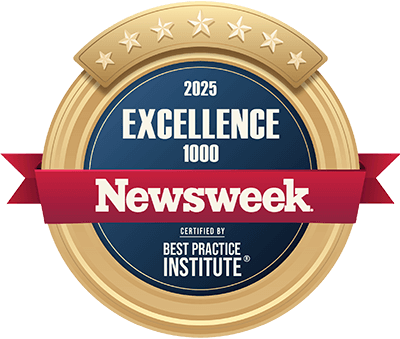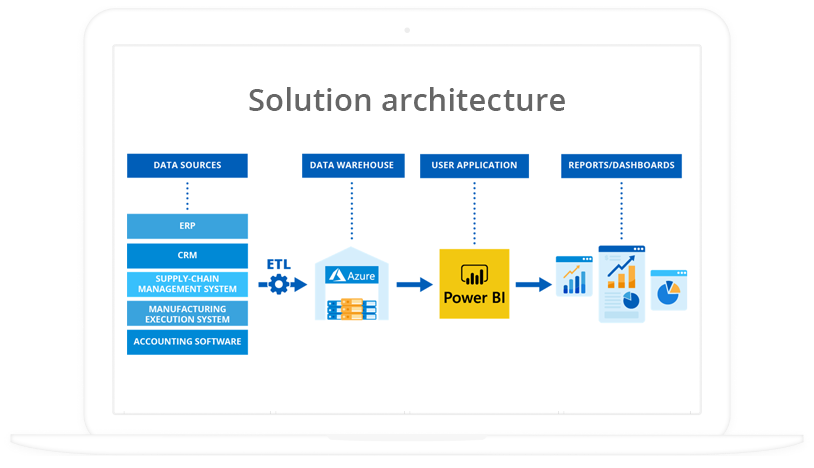Application Integration on Azure
Required Steps, Roles, Services
Having 36 years in IT, 13 years of experience in Azure consulting and related services, ScienceSoft advises on and implements app integration on Azure.
Application Integration on Azure: the Gist
Application integration on Azure implies building connection between any cloud and/or on-premises applications using Microsoft Azure services (API Management, Azure Event Grid, Azure Logic Apps, etc.).
App integration on Azure is a natural choice for organizations using Microsoft software or any services within the Azure platform and organizations looking for integration flexibility in order to meet specific business and technical needs that ready-made integration solutions (MuleSoft, Boomi, etc.) can’t grant.
A typical Azure-based integration process consists of scoping and planning the integration, designing the integrated system, implementing and testing the integration. It can be carried out by a team of a project manager, a business analyst, an Azure Solution Architect Expert, developer(s), QA engineer(s), and a DevOps engineer.
Note: Azure Integration Services are best-suited for application integration. For data integration, ScienceSoft recommends Azure Data Factory to ingest, prepare and transform data, Azure Synapse Analytics to build data pipelines with the ETL/ELT process, and Azure Data Lake Storage to store and process unstructured big data.
In software development since 1989, ScienceSoft helps build reliable, secure and convenient Azure-based integrations between custom and/or commercial systems.
So, How to Integrate Apps Using Azure?
The stages and timelines of an Azure-based integration project can vary depending on the number of applications integrated, their architecture, required changes in legacy software, the chosen integration approach(es), and more. Below are the most common steps of Azure-based integration projects at ScienceSoft.
Step 1. Scope and plan the integration
Duration: ~1-3 weeks
|
|
Best practice: Before starting an Azure-based integration, we always check whether compliance requirements for the new integrated system allow for the usage of cloud services and whether Azure adheres to the required security controls. |
- Elicit business requirements for a future integrated system.
- Analyze software to be integrated to understand its capabilities and constraints.
- Elicit IT infrastructure capabilities and constraints (for hybrid integration).
- Figure out how data should flow between integrated apps and whether it needs to be transformed into a different format.
- Calculate the value and cost savings that Azure-based cloud integration can bring considering the specifics of your business and IT environment, and the required onward cloud investments.
- Define business metrics to measure integration success (e.g., improved order processing/delivery time, reduced transaction errors, optimized spending on storage, compute and app maintenance).
Step 2. Design the integrated system
Duration: ~1-3 weeks
- Design an application integration architecture.
- In accordance with the designed architecture, decide on the optimal stack of Azure services to use (for orchestration, data storage, etc.).
- (if required) Plan code adjustments in the applications under integration. Note: app modernization may take from 2-3 weeks to 2-3 months.
Step 3. Implement and test the integration
- Implement the required changes/adjustments to the applications under integration.
Further steps differ depending on the application integration architecture and tech stack that we choose.
- Set up the log messages/events from the integration solution to be sent to Azure Stream Analytics, and/or Azure Event Hubs, and/or Microsoft Power BI to analyze the solution’s performance.
- Validate the integration:
1
Verify all uni-, bidirectional, and asynchronous (orchestration) queries between the connected applications to check the completeness of distributed transactions and data consistency.
2
Approve failover and recovery mechanisms to ensure that no issues can spread over and disrupt the work of the integrated apps.
3
Perform sufficient security tests. APIs and cloud-hosted software are highly vulnerable to security attacks.
ScienceSoft’s Offering in Application Integration
Azure-based application integration consulting
- Business and technical requirements for the integrated system.
- Integration architecture design.
- Planning required modifications of the integrated applications.
- Guide to compliance with the required security certifications/regulations (HIPAA, HITECH, SOC2, SOC3, and more).
- A detailed app integration project roadmap.
Azure-based application integration implementation
- Requirements analysis.
- Application and infrastructure analysis.
- The integration architecture design.
- Migration and modernization (re-engineering, re-architecting) of applications (if required).
- Integration solution development, implementation and testing.
- After-launch support, user and admin training.
- Continuous management and evolution of the integrated system (on demand).
ScienceSoft as a Reliable Partner in Azure-based App Integration
We wanted our product to integrate with various ticketing software to collect support tickets, analyze them with AI, and organize the elicited data into charts and visuals.
ScienceSoft’s team undertook the development of our product from scratch and showed deep expertise in the .Net environment and AWS and Azure services.
Bob Penland, Managing Partner, ServicePulse
Why ScienceSoft?
- In IT since 1989.
- Microsoft partner since 2008.
-
Project kick-off in 2 days to 2 weeks.
-
Integration and database architects with 7–20 years of experience.
- In cloud development and migration since 2012.
- In DevOps since 2013.
- 22 years in cybersecurity. All-level security configuration and monitoring (infrastructure, application logic, security testing, compliance).
- Serving 30+ industries with an exceptional focus on healthcare and BFSI, backed by over 20 years of experience in each.
- Mature quality management backed by ISO 9001.
- Robust security management supported by ISO 27001.
- Compliance with HIPAA, GAMP, PCI DSS, and more.
Our awards, certifications, and partnerships
Sample Skills and Roles Required for the Azure Application Integration Project
Project Manager
- Plans the app integration project, assigns project tasks and responsibilities to the integration team and controls task execution.
- Ensures that the project is implemented on time and budget and in compliance with the set quality metrics.
- Reports to the key stakeholders on the progress of the Azure-based app integration project.
Business Analyst
- Elicits, prioritizes, and documents requirements for the integrated system and the Azure-based integration solution.
- Chooses the integration approach (in collaboration with integration architect).
Azure Solution Architect Expert (for complex integrations)
- Designs the integration architecture to meet the business and technology requirements.
- Develops the architecture transformation and modernization roadmap for the apps under integration (if necessary).
- Defines API design.
- Defines Azure services to be employed.
Developer
- Builds custom integration software and APIs.
- (for Azure Logic Apps) Sets up request triggers in case of pre-built integration, chooses resulting actions, and selects data to be shared.
DevOps Engineer
- Plans, configures, tests and optimizes the integration solution infrastructure.
- Automates integration solution development and release processes by introducing a CI/CD pipeline.
- Monitors the integrated system security, performance, availability, etc.
QA Engineer
- Designs and implements a test strategy, a test plan and test cases for the integration solution and the integrated system to assure that the functional, data consistency, security, and compliance requirements are met.
- Creates and conducts manual and automated test cases.
- Tracks test results, reports bugs.
|
|
Best practice: In our integration projects, we choose to involve QA engineers with a good understanding of the to-be integrated application and integration architecture elements (e.g., messaging technologies used). |
Sourcing Options for Azure-based Application Integration Projects
The entire Azure-based integration project is in-house
Pros:
- Full control over the project progress.
- Easier team communication.
Cons:
- Specific resources with experience in Azure services, modern integration patterns, legacy app modernization may be required.
- All hiring and managerial efforts are on your side.
The Azure-based integration project is outsourced
Pros:
- A vendor assumes full responsibility for the team assembly and management and the quality of the integration project delivery.
- Established Azure-based app integration frameworks.
Cons:
- High vendor risks.
A mix of in-house team and outsourced consultancy for Azure-based integration
Pros:
- In-house team has a deep understanding of internal business processes and software environment.
- Outsourced consultancy provides expert guidance, mentors through the most challenging integration activities, shares specific Azure knowledge, trains your team to efficiently maintain the integrated solution.
Cons:
- Risks of consultancy vendor selection.
- Requires time and experience to establish smooth collaboration and communication between the in-house and consultancy teams.
- Partial or total project team coordination, quality control and risk management are required from your side.
Benefits of Application Integration with ScienceSoft
Data quality
ScienceSoft introduces data governance rules, error message management, message completeness verification, roll-back of distributed transactions to ensure consistent and comprehensive data across the integrated system.
Advanced integration security
ScienceSoft uses sophisticated access control rules, industry-proven protocols for authentication and authorization, “safer” outbound connections, and more.
System performance management
ScienceSoft pays special attention to planning system capacity and middleware, designs scalable architecture, introduces priority queues, effectively uses timeouts and sync calls, logging and caching, conducts load and performance testing, network latency problem assessment.
Optimal integration journey
ScienceSoft starts with a feasibility study of its technical, economic and operational aspects of your integration initiative. Our consultants with 7-20 years of experience in the field investigate whether the project is worth your time and money and which integration scenario will bring max benefit.
Costs of Application Integration on Azure
Among major cost factors are:
Basic integration costs
- The chosen integration approach (point-point, mediated integration, workflow-based).
- Number of integrated apps.
- The complexity of the new integrated workflow (whether it can be created codeless, with minimal code adjustments or by writing custom code).
- The availability of ready APIs and connectors.
- Modifications and/or cloud migrations of the applications under integration (if required).
- Efforts for testing the co-coordination and data consistency between the integrated systems.
Cloud service-related costs
- Azure services used.
- Number of operations for a certain period (messages, events, delivery attempts, management calls, etc.).
- Message size.
- Specific features required from cloud-based integration software (message transactions, de-duplications, sessions, etc.).
- The required level of Azure cloud support provided by Microsoft, and more.
Business costs
- Integration ramp-up.
- Business user training.
An Overview of Azure Application Integration Services
Azure offering comprises numerous services you may need for app integration, e.g., data storage services, serverless computing service (Azure Functions) to write custom data transformation, and more. Here, we list the core Azure services used for application integration: Azure API Management, Azure Service Bus, Azure Event Grid, and Azure Logic Apps. All the services are sold individually, so you’re free to use only the services you need.
API Management
Best for
Providing API service.
Description
- Provides a simple-to-use tool for API compliance and governance control required to ensure that the exposed API is used appropriately and data exchanged between apps is presented in the correct format.
- Ability to restrict access to APIs on multiple levels (comes with many predefined policies out-of-the-box).
- Built-in protection from attacks on APIs with throttling.
- Provides monitoring tools and access control to gain insights into the API use.
Pricing
Azure Event Grid
Best for
Near real-time event raising and delivering
Description
- Simple and fast way to invoke an event handler when the specified event occurs.
- Supports up to 10,000,000 events per second in a single Azure region.
Pricing
Azure Service Bus
Best for
Providing secure and reliable async communication (order processing, financial transactions, etc.)
Description
- Message persistence and strict first-in, first-out ordering of messages.
- Guaranteed in-order message delivery.
- Detects and deletes duplicate messages.
- Atomic transactions, letting a queue read or write be part of a larger operation that succeeds or fails as a single unit.
- Poison message handling.
- High availability, including geo-replication and built-in disaster recovery.
Pricing
Azure Logic Apps
Best for
Orchestration of business processes, workflows, and more
Description
- A visual designer for workflow creation.
- Includes ~ 200 connectors to popular protocols, hybrid & enterprise solutions (BizTalk, SAP, etc.), Azure services and other Microsoft products (e.g., Office 365), popular third-party SaaS solutions (e.g., Slack).
- Handling authentication of API requests, check-pointing, durable execution.
- Azure Functions can be used within Azure Logic Apps for complex orchestration based on custom code.
- Microbilling (per action billing) is available.
Pricing
About ScienceSoft
A global IT consulting and IT services company headquartered in McKinney, TX, ScienceSoft provides end-to-end application integration services. Project success is our standard, not a slogan. We drive projects to their goals by overcoming constraints, designing architectures that prioritize business value, and bringing in experts trained for clients’ specific industries, workflows, and technologies.
- 13 years of experience in Azure services.
- A member of Microsoft Cloud Solution Provider (CSP) program.
- Microsoft Certified Solutions Experts (MCSE), Microsoft Certified Professionals (MCPS) on board.
As the holder of ISO 9001 and ISO 27001 certifications, we rely on mature quality management and guarantee that the cooperation doesn't pose any risks to our clients' data security.



